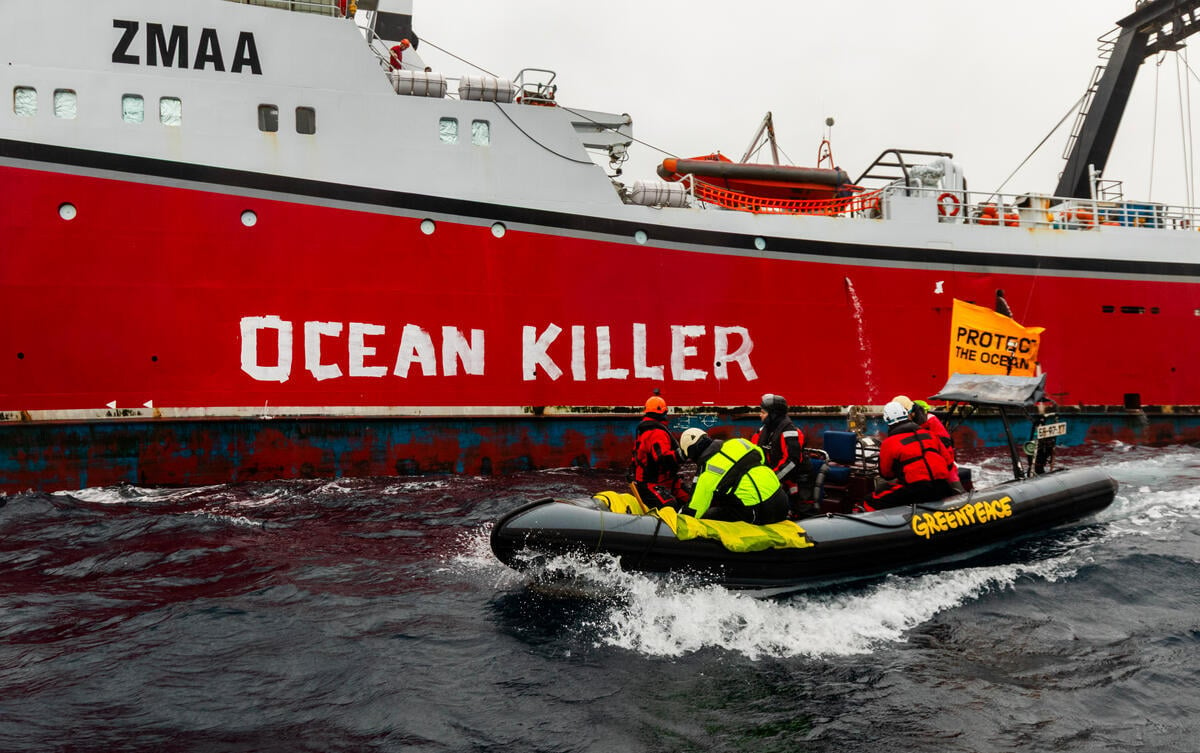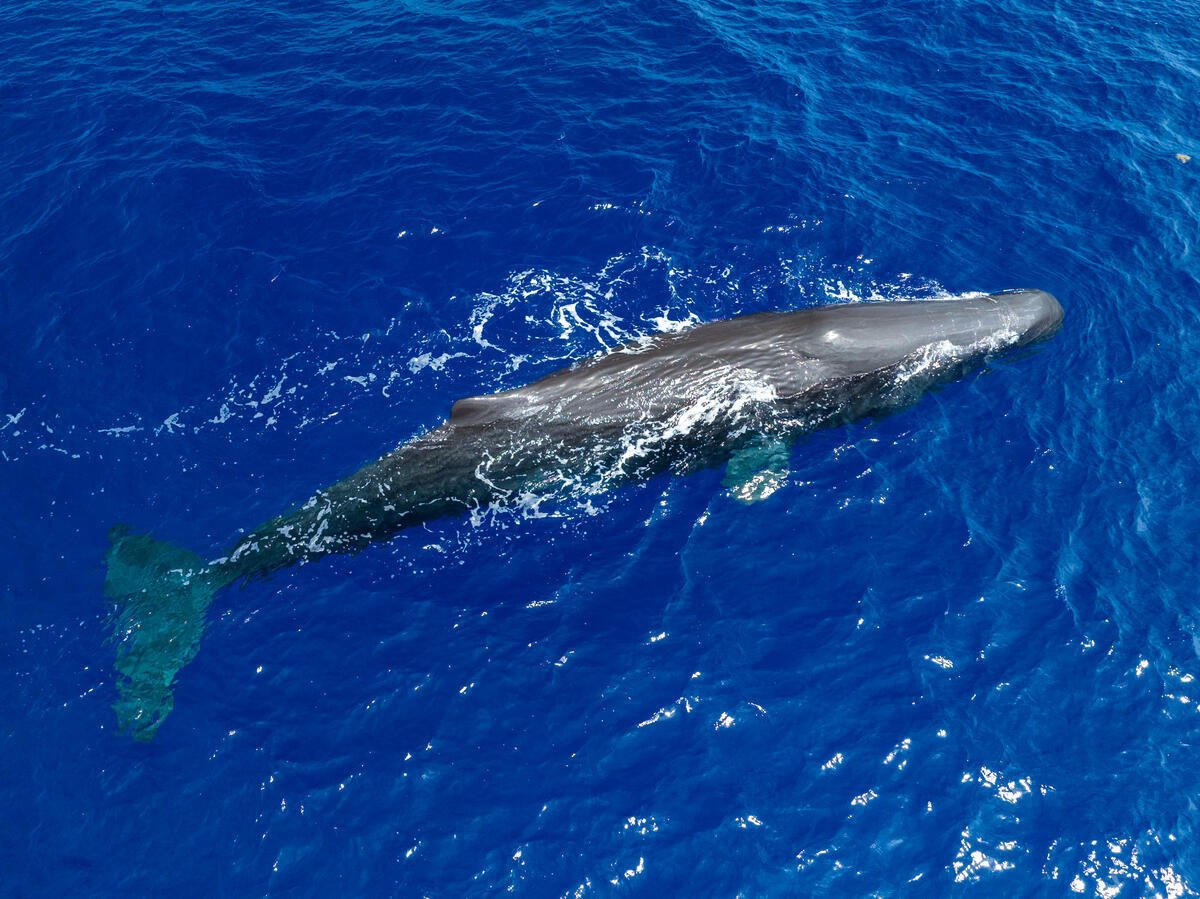We know, even by casual observation, that humanity has disrupted the balance of life on Earth, eradicated habitats, reduced biodiversity, and driven some species to extinction. Now, an updated Census of Earth’s Biomass reveals some details of this transformation of the species diversity on Earth.
The study – by Yinon M. Bar-On and Ron Milo from the Weizmann Institute of Science in Israel and Rob Phillips from the California Institute of Technology, published on June 19, 2018, in the Proceedings of the National Academy of Sciences – compiles hundreds of global and local studies from recent decades, including revised estimates for certain families, phyla, and kingdoms of organisms.
We find out that humans and their livestock now comprise about 96% of all mammal biomass on Earth. All other mammals – whales, sea lions, bears, elephants, badgers, shrews, deer, bear, cougars, rats, wolves, and all the rest – are about 4.2%.
Mammals, including humans and their livestock, represent only about 0.03% of Earth’s biomass. All animals – the mammals plus fish, insects, worms, birds, and others – account for only 0.37% of biomass. The two primary producers of biomass from solar energy – plants and bacteria – still dominate terrestrial and marine life forms, accounting for over 95% of all living biomass.
Global Biomass Distribution
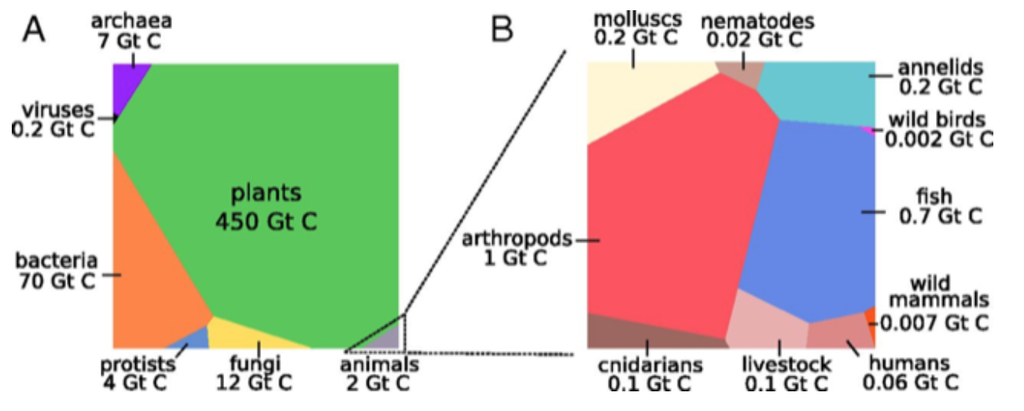
Voronoi diagram of global biomass distribution (used with permission from the Bar-On, Phillips, Milo census)
The ancient foundation
Bacteria tell a long, significant story. They arose from organic molecules some 3.5 billion years ago and for nearly 2 billion years, cyanobacteria and their single-cell prokaryote and archaea cousins were the only life forms on Earth.
As bacteria evolved to transform solar energy through photosynthesis, their populations surged. This growth, however, released oxygen into the oceans and induced the first mass extinction in recorded history: The great oxygen poisoning, between 2.5 and 2.1 billion years ago. Since oxygen acted as a toxin to anaerobic bacteria, many species perished, until organisms that could metabolize oxygen evolved to clean up the pollution. Oxygen-breathing organisms restored the carbon-dioxide balance, allowing plants to flourish. Meanwhile, fungi occupied the anaerobic underworld.
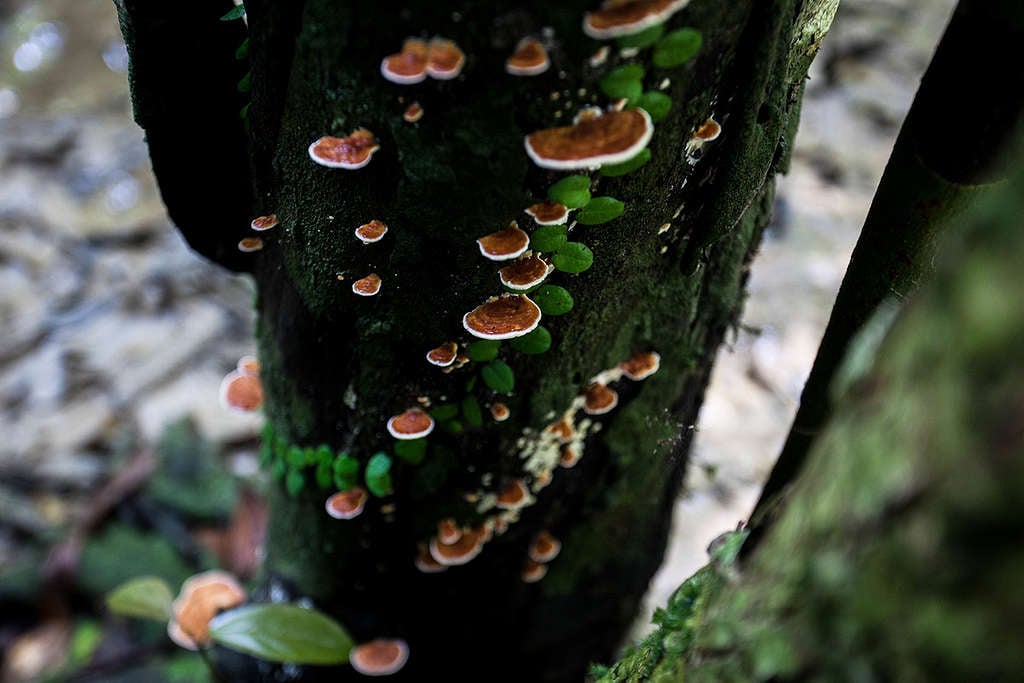
Fungi in the rainforest in Kalasou valley, Sorong, West Papua.
Today, these ancient life forms – archaea, fungi, bacteria, protists, and plants – comprise 99.6% of all biomass on Earth. Biologists measure biomass as “Gigatons of Carbon” (GtC). Here is a summary of Earth’s modern biomass distribution from the Bar-On, Phillips, Milo census:
Earth’s Total Biomass: 545.2 gigatons of carbon (Gt C)
| plants | 450 Gt C | 82.54 % | primarily terrestrial |
| bacteria | 70 Gt C | 12.84 % | deep subsurface |
| fungi | 12 Gt C | 2.20 % | shallow subsurface |
| archaea | 7 Gt C | 1.28 % | deep subsurface |
| protists | 4 Gt C | 0.73 % | primarily aquatic |
| animals | 2 Gt C | 0.37 % | primarily marine |
| viruses | 0.2 Gt C | 0.04 % | all ecosystems |
Although this analysis provides a reliable summary, uncertainties remain, particularly with deep marine and subsurface organisms. Bacteria, fungi, archaea, and protist biomass could be greater than calculated, whereas plant and animal biomass estimates are considered more reliable.
Plants, which began as marine organisms, are now predominantly terrestrial and comprise most (over 80 %) of all life biomass on Earth, in spite of extensive human deforestation and desertification of grasslands. Although over 99% of biomass is terrestrial, animal biomass is predominantly marine, in the form of fish and zooplankton.
On land, producer biomass (plants and bacteria) exceeds consumer biomass. In the oceans, however, the biomass of consumers exceeds that of producers, which seems curious until we consider that large marine consumers feed on smaller consumers, whereas on land, the largest consumers are herbivores.
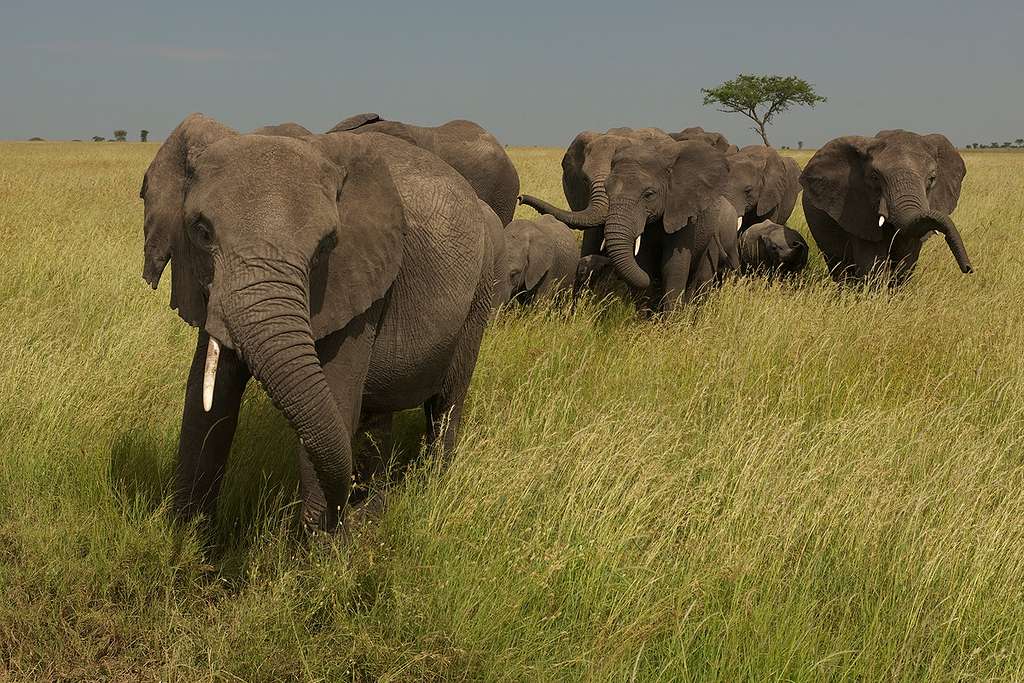
Elephants in the Masai Mara Savanna, Kenya, Africa.
Only 60% of global biomass exists above-ground and in the oceans (~ 320 GtC). The rest exists below-ground, as plant roots (130 GtC) and as microbes in the soil and deep subsurface (~100 Gt C). About 30% of plant biomass exists below the surface as roots, engaged in symbiosis with fungi, bacteria, and other microbes.
The human impact
From the summary, above, we see that animals – from zooplankton and fish to humans and whales – comprise only a tiny portion of Earth’s living organisms. If we look only at the animals, 0.37 % of all biomass, we see this distribution:
Earth’s Animals: 2 gigatons of carbon (Gt C)
| arthropods | 1.000 Gt C | 50.00 % | crustaceans, insects, spiders |
| fish | 0.700 Gt C | 35.00 % | marine, fresh water |
| molluscs | 0.200 Gt C | 10.00 % | primarily marine |
| annelids | 0.200 Gt C | 10.00 % | segmented worms, leeches |
| mammals | 0.167 Gt C | 8.35 % | terrestrial & marine |
| cnidarians | 0.100 Gt C | 5.00 % | coral, jellyfish, hydrozoa |
| nematodes | 0.020 Gt C | 1.00 % | parasitoid worms |
| wild birds | 0.002 Gt C | 0.10 % | terrestrial, water birds |
| amphibians | < 0.001 GtC | < 0.01 % | considered “negligible” |
| reptiles | < 0.001 GtC | < 0.01 % | considered “negligible” |
Half the mass of Earth’s animals are arthropods: spiders, beetles, insects, and crustaceans. Insects, dominate in species richness, with over a million described species. Certain Antarctic krill species, such as Euphausia superba, contribute as much biomass as humans, and a single species of termite can surpass the biomass of all birds.
However, even considering their predominance, insects have suffered from human sprawl, disappearing habitats, and from pesticide use. Biologists have found over 150 foreign chemical residues in bee pollen, which University of California apiculturist Eric Mussen calls “a deadly pesticide cocktail.” The primary culprits are nicotinoid pesticides, common commercial products used by Bayer/Monsanto, Syngenta, BASF, Dow, and DuPont chemical companies. Other insects, including butterfly, cicada, and beetle species are disappearing from certain regions.

Certain Antarctic krill contribute as much biomass as humans
Most other animals are fish. Mammals account for only about 8 percent of animal biomass and only about 0.03% of all biomass. However, within the realm of mammals, humans dominate. Human livestock, at 0.1 Gt C, account for 59.9% of all mammal biomass on Earth; humans themselves, at 0.06 Gt C, account for 35.9 %. All wild mammals, marine and terrestrial, account for only 4.2% of mammal biomass.
Since our ancestors developed fire technologies, weapons, and agriculture, humanity has dominated terrestrial life on Earth. Beginning about 50,000 years ago, human activity has contributed to megafauna extinctions, the loss of 178 species of the world’s largest mammals. Over 100 entire genera perished, including camels, horses, ground-sloths, sabre cats, and glyptodonts (large armadillos).
The greatest changes have occurred since the advent of agriculture. According to the a 2011 biomass census compiled by Vaclav Smil, human activity over the last 5,000 years has reduced total global biomass by about 50 percent, from over 1,000 Gigatons of Carbon at the dawn of agriculture to the current 545 GtC. The decline, through wild harvesting and habitat conversion, continues.
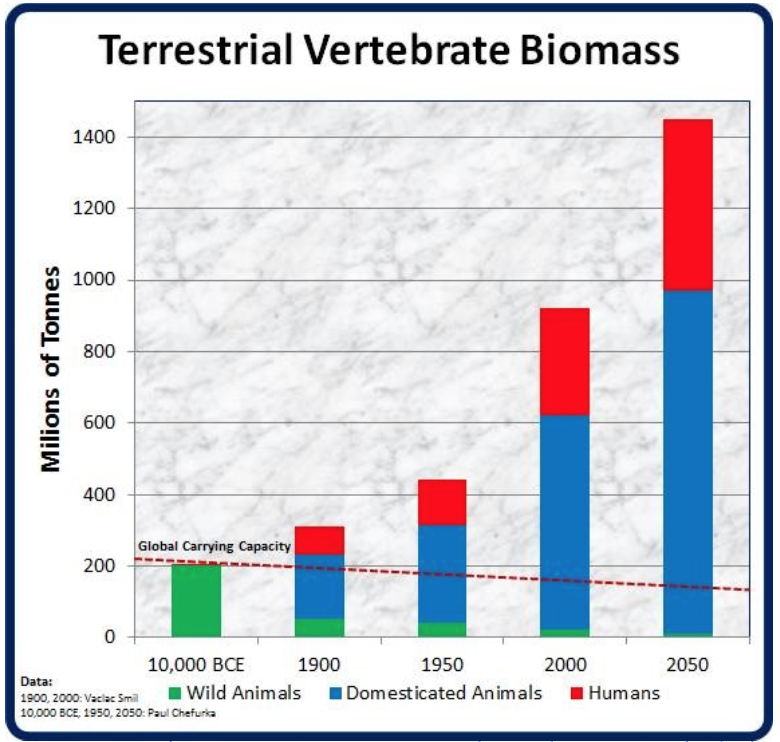
The dominance of humans among terrestrial vertebrates. Paul Chefurka and Vaclav Smil
In the oceans, human fishing has depleted 85% of commercial fish stocks and 90% of “big fish” – tuna, marlin, and sharks. The global marine catch is down by 6.4% since the 1992, in spite of larger ships, larger nets, and improved technology. Oxygen-depleted ocean zones have increased by 75%. This is on top of acidification from carbon emissions which kills coral reefs that act as marine breeding grounds. The exploitation of marine mammals, including whales, has reduced marine mammals by 80%.
About half of Earth’s forests are gone. Six billion hectares of Pleistocene forests have been reduced to three and a half billion hectares. Much of the remaining forests survive as tree farms or skeletal forests with declining plant and animal life. When we account for this, we find that humanity has degraded or destroyed about 70% of the world’s forests, and annually, we lose about 13 million hectares.
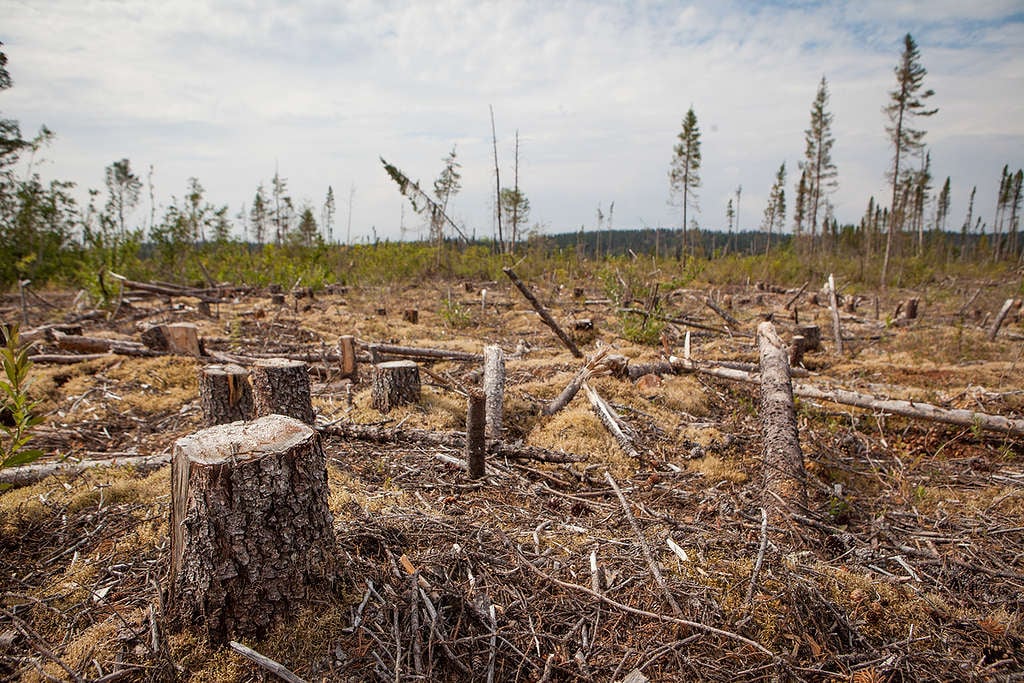
Clearcut affected forest in Cree territory, Northern Q
Between 1970 and 2012, vertebrate abundance declined by 29 % and, collectively, fish, amphibians, reptiles, birds, and mammals have declined by 58%. The domesticated poultry of humans (primarily chickens) account for two-and-a-half-times the biomass of all wild birds. Reptiles and amphibians have been so thoroughly reduced that they are considered “negligible” as biomass in this current census.
To slow or reverse this erosion of biodiversity, humanity must slow its harvest of the natural biosphere and cease the destruction, depletion, and conversion of wild habitats, leaving places on Earth for non-human life to flourish.
Rex Weyler is an author, journalist and co-founder of Greenpeace International.
References and Links:
Biomass Study, Bar-on, Phillips, Milo: Proceedings of the US National Academy of Sciences, May 21, 2018; Article #17-11842; PNAS.
Summary of the Bar-on, Phillips, Milo Biomass Study: American Association for the Advancement of Science: AAAS, Summary.
Whitman WB, Coleman DC, Wiebe WJ, “Prokaryotes: The unseen majority;” PNAS, US 95:6578–6583, 1998:
“Where have all our insects gone?” Dave Goulson, Sussex University; The Guardian.
Atkinson, Siegel, et al. (2009) “Biomass and annual production of Antarctic krill”; Oceanographic Research Papers 56:727–740. Science Direct.
Sanderson M.G. (1996), “Biomass of termites and their emissions of methane and carbon dioxide”; Global Biogeochemical Cycles 10:543–557; AGU.
The seven bee-killer pesticides: clothianidin, imidacloprid, thiametoxam, clorpyriphos, cypermethrin, deltamethrin, and fipronil: Greenpeace Bee report.
“Honey Bee Collapse: A Lesson in Ecology,” Rex Weyler, Deep Green, Greenpeace International, June, 2013.
Barnosky A., “Megafauna biomass tradeoff as a driver of Quaternary and future extinctions,” Proceedings of the National Academy of Science (US), 2018; 105:11543–11548: PNAS.
Vaclav Smil: “Harvesting the Biosphere: The Human Impact,” Population and Development Review 37(4): 613–636, Dec. 2011, pdf:
Paul Chefurka, Carrying Capacity and Overshoot, another look: paulchefurka.ca
Paul Chefurka graph, humans and vertebrates; Nov. 2017, Peak Oil Barrel.


